 Image search results - "koga" Image search results - "koga" |

Cherry tree forest near the Nishi-guchi (west) gate.
|
|

The outdoor architectural museum is within Koganei Park in Koganei, Tokyo. This is the Visitors Center.
|
|

Koganei Park sakura
|
|

Going to visitors center
|
|

Huge trees shower you with cherry blossoms.
|
|

Visitors Center entrance courtyard
|
|
|
|
|
|
|

Low branches are common
|
|

Jisho-in Mausoleum
|
|
|
|

Mansion of Mitsui Hachiroemon, one of the museum's must-see buildingsFounder of the Mitsui zaibatsu.
|
|
|

Inside Mitsui Hachiroemon mansion
|
|
|
|

Tokiwadai Photo Studio, 1937Unfortunately, it was closed for renovations. It has a large frosted glass which brought in daylight for studio lighting.
|
|
|

Farmer's house
|
|
|
|

Farmer's house
|
|
|

Inside farmer's house
|
|
|
|

Inside farmer's house
|
|
|

Another farmer's house
|
|
|
|

Inside another farmer's house
|
|

Path to other areas of the huge park.
|
|

Yamanote-dori Road
|
|

Tall one
|
|

Takahashi Korekiyo mansion
|
|
|
|

Another cherry tree forest near the center of the park.
|
|

Orge's shack
|
|

Reaching low
|
|

Shitamachi main street
|
|

Visitor's center entrance to the outdoor architectural museum.
|
|

Takei Sanshodo stationary shop
|
|

Cherry blossom promenade
|
|

Takei Sanshodo stationary shop
|
|
|
|
|
|

On the left is a soy sauce and miso shop. On the right is a public bath.
|
|
|
|

Soy sauce shop
|
|

Low-rider cherries
|
|

Soy sauce shop
|
|

Typical Somei-Yoshino cluster of cherry blossoms
|
|

Tavern
|
|

Cherry blossom curtain
|
|

Sento public bath with a temple architectureNamed Kodara-yu.
|
|

This was a weekday.
|
|

Entrance to sento public bath. Men on left and women on right.
|
|

Beautiful day
|
|

Fee collector booth at entrance.
|
|
|
|

Changing room
|
|

Tree branches sprawled all over the blue sky.
|
|

Bath entrance
|
|

Cherry blossom veil
|
|

Bathing area
|
|
|

It says, "Don't open the faucet. Water might flow."
|
|
|
|

Bath tub
|
|
|
|
|
|
|

Cherry blossom ceiling
|
|

Men's bath
|
|

Cherry blossom roof
|
|

Buckets
|
|

Cherry blossom tent
|
|
|
|
|

Kami-shibai (Storytelling with large paper cards)Popular before the days of television.
|
|
|

Kami-shibaiSlot to change the story cards.
|
|

Bicycles and cherries
|
|

Old streetcar
|
|

In front of entrance to visitors center
|
|

Inside streetcar
|
|

Old bus
|
|
|

Fireman's watch tower
|
|
|

Police box at Manseibashi in Tokyo
|
|

Cherry blossom shade
|
|
|
|

Plum blossom trees (withered)
|
|

Nishikawa Villa
|
|

The Three Treasures (in the 1960s): 1. Washing machine with manual wringer
|
|

Red cherries called kanhi-zakura カンヒザクラ
|
|

2. Refrigerator
|
|

Red drooping cherries called kanhi-zakura カンヒザクラSimilar to a rose.
|
|

3. TV set
|
|

Red drooping cherries called kanhi-zakura カンヒザクラSimilar to a rose.
|
|

Kōgan-ji Temple (高岩寺)
|
|

Gate to Koganji temple, a famous spot along the shopping street.
|
|

Koganji temple. The temple's popular name is "Togenuki Jizo-son." It sells magic paper called osugata which supposed to remove a thorn or splinter from your skin. Affix it to the thorn and it will be extracted. とげぬき地蔵尊
|
|

Togenuki means thorn-extracting. Koganji temple incense burner
|
|

Koganji temple Hondo hall. This is a Zen temple belonging to the Soto-shu school. The temple was founded in 1596 and moved to Sugamo in 1891.
|
|

Inside Koganji temple Hondo. The temple houses the Togenuki Jizo statue which is not visible to the public.
|
|

Grounds of Koganji temple as seen from the Hondo hall.
|
|

People line up to wash the famous Kannon statue. The line gets longer on weekends.
|
|

People in line for the Arai (Washable) Kannon statue. Anybody can line up and scrub the statue. No charge.
|
|

Arai Kannon statue. Wash the part of the body to cure the corresponding part of your own body. 洗い観音
|
|

They used to have a tawashi brush to wash the statue, but that wore out the statue. So the replacement statue is now washed/rubbed with a towel instead.
|
|

Jizo statue
|
|

Jizo statue
|
|

People relax in front of the temple.
|
|
|
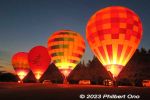
The "Balloon Glow" event at Koga Kubo Park in Jan. 2023 was colorful and impressive even when the balloons did not fly. Free event, mainly local crowds.This was actually a 2022 Christmas Eve event, but it was postponed twice due to bad weather or strong winds. Finally held on Jan. 22, 2023.
|
|
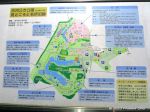
Map of Koga Kubo Park. Large park noted for peach blossoms from late March to early April. Also has irises and lotus in summer. 古河公方公園
|
|

Koga Kubo Park has Gosho-numa Pond.
|
|

Koga Kubo Park opened on March 24, 1975. It's quite a large park.
|
|
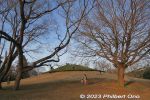
Fujimi-zuka Hill 富士見塚
|
|
|
|
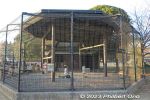
Pheasant bird cage. 鳥小屋
|
|
|
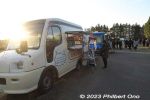
Food trucks for the balloon glow event.
|
|

Kubo Park's grassy lawn where four hot-air balloons were placed, rolled out flat on a blue tarp over the grass. 芝生広場
|
|
|
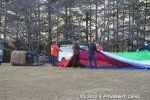
Inflating the balloon.
|
|
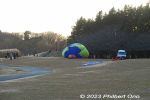
The balloons inflated quite quickly.
|
|
|
|
|
|
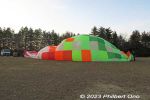
Inflating the hot-air balloon.
|
|
|
|
|
|
|
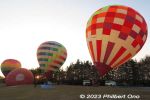
Hot-air balloons are vulnerable to strong winds. See how the balloon can sway in strong winds.
|
|
|
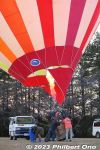
Burner is lit every so often to maintain the hot air.
|
|
|

They started blowing flames into the balloon.
|
|
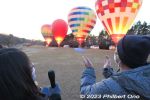
The MC came up to the crowd and asked people to give the word to light up the balloons.
|
|
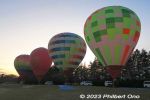
Standing by for sunset.
|
|
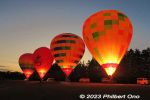
When it got dark enough, all four balloons lit up their balloons simultaneously numerous times during the one-hour event.
|
|
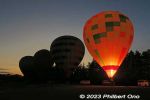
The balloon lights up only when the burner is shooting a flame under it. The flame illuminates the entire balloon.
|
|
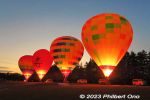
This photo was taken during the several seconds when the burners of all four balloons were flaming into the balloons at the same time.
|
|
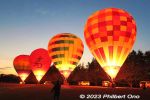
All four balloons lit up at the same time many times during the one-hour balloon glow event. They played J-pop music in the background.
|
|
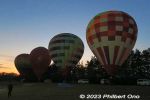
This is how it looks when they are dark.
|
|
|
|
|

Crowd-pleasing event.
|
|

The 37th Koganei Awa Odori dance festival was held on July 25-26, 2015 from 6 pm to 9 pm in Koganei, Tokyo. A total of 43 dance troupes (2,800 performers) appeared during the two-day festival. Many are based in Koganei.
|
|

Musashi-Koganei Station is crowded on Awa Odori evenings.
|
|

Starting point of the dancers near the train station. 小金井街道北口
|
|

Awa Odori dance troupes are called "ren."
|
|

Aoi Shin-ren
|
|

Also watch my YouTube video of Koganei Awa Odori.
|
|

Also watch my YouTube video of Koganei Awa Odori.
|
|

Aoi Shin-ren
|
|

Aoi Shin-ren
|
|

Aoi Shin-ren
|
|

Aoi Shin-ren
|
|
|
|
|
|
|

Sakura-ren is from Koganei
|
|

Sakura-ren
|
|

Sakura-ren at Koganei Awa Odori in July
|
|

Sakura-ren
|
|

Sakura-ren
|
|

Sakura-ren
|
|

Sakura-ren
|
|

Seibu Kodomo-kai-ren
|
|

Seibu Kodomo-kai-ren
|
|

Seibu Kodomo-kai-ren
|
|
|
|
|
|
|
|
|

Koganei Awa Odori, Tokyo
|
|
|

Kurenai-ren
|
|

Kurenai-ren
|
|
|
|
|
|
|
|
|
|
|
|
|
|

Koganei Awa Odori
|
|
|
|
|
|
|
|
|
|
|
|
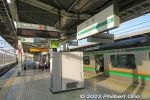
JR Koga Station (Tohoku Main Line or Utsunomiya Line) is the closet train station to Kubo park.
|
|
|
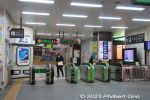
JR Koga Station turnstile.
|
|
|
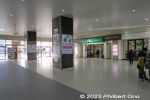
JR Koga Station
|
|
|
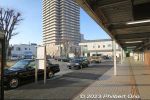
JR Koga Station west exit.
|
|
|
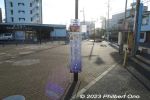
There were free shuttle buses from Koga Station (west exit) going to and from the park.
|
|
|

Shuttle bus schedule from JR Koga Station to Kubo Park.
|
|
|
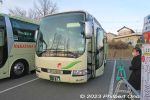
Free shuttle buses from Koga Station going to and from the park. This is the Kubo Park parking lot. The return bus is also here.
|
|
|
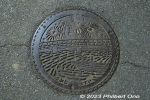
Manhole in Koga, Ibaraki Prefecture showing fireworks and river.
|
|
|
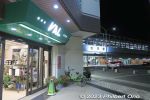
JR Koga Station has a shopping mall named VAL.
|
|

Koganei Awa Odori, Tokyo
|
|

JR Koga Station has a shopping mall named VAL.
|
|
|
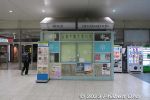
JR Koga Station information center (closed).
|
|
|
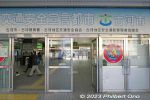
JR Koga Station east entrance.
|
|
|
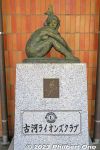
JR Koga Station east entrance sculpture.
|
|
|
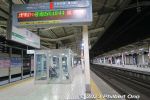
JR Koga Station platform. About 73 min. by train from central Tokyo.
|
|
|
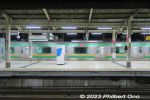
JR Koga Station platform.
|
|
|
|
|
|
|
|
|
|
|
|
|

Sakura-ren
|
|

Sakura-ren
|
|
|
|
|
|
|
|
|